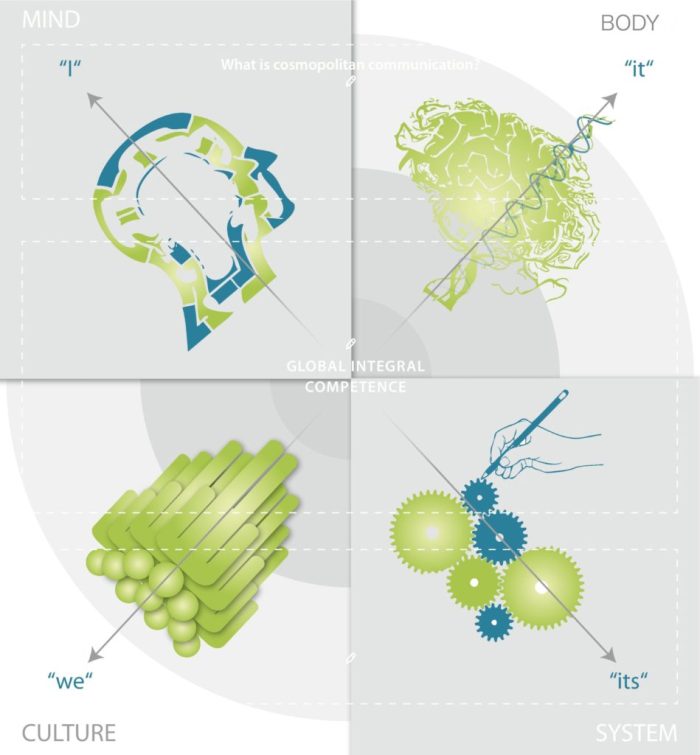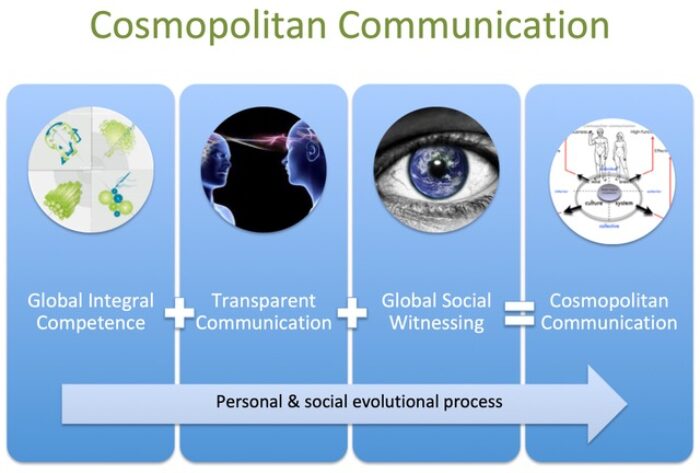Global Integral Competence
Global competence is a multidimensional capacity. Globally competent individuals can examine local, global and intercultural issues, understand and appreciate different perspectives and world views, interact successfully and respectfully with others, and take responsible action toward sustainability and collective well-being.
Why do we need global competence?
To live harmoniously in multicultural communities. Education for global competence can promote cultural awareness and respectful interactions in increasingly diverse societies.Engage in open, appropriate and effective interactions across cultures.
One of our main integral competence skills, which we research, develop and promote is a cosmopolitan communication.

Cosmopolitan Communication
To promote cosmopolitan communication as simply another form of intercultural competence is not sufficient because this concept traditionally considers just a small, predominantly cognitive subset of the whole spectrum of human life, social development, and international exchange. We must instead develop a new level of competence that covers all dimensions of human communication: intra-, inter- and transpersonal communication. Only then will we have communication that deserves to be called “cosmopolitan.” The three types of communication just described – intra-, inter- and transpersonal communication – can be redefined and described based upon the integral map.

Three dimensions of communication

Intra-personal communication: communication with self
- Communication with body/brain. The body is constantly sending out signals that can tell us a great deal about ourselves if we learn and understand them. Although much is yet to be learned about how we can control bodily functions, biofeedback is being used to help people decrease tension and anxiety, to increase or decrease particular brain waves, to cure migraine headaches and other bodily ills.
- Communication with mind/soul. Intra-personal communication limits itself to communication within the individual. It is communication that takes place within the individual when she/he is communicating with others, or simply when she/he is alone and thinking to her-/himself. When a person says to her-/himself, “way to go,” she/he is engaging in intra-personal communication. The practice of intra-personal communication is critical to helping us develop not only our sense of self but also help us identify how to communicate with others. Our value of ourselves determines how we communicate with others so it is important to assess our self- concept.
Inter-personal communication: communication with others
Communication exists on a continuum from impersonal to interpersonal. Much of our communication involves no personal interaction. We acknowledge each other as people, but we don’t engage in intimate talk. Buber (1958) says that this continuum exists at levels: I-It, I-you, and I-Thou.
- I-It communication: in this relationship we treat other very impersonally, almost as objects. We simply interact because we need to, but do not see individuals as human beings. – I-You Communication: This is the second level according to Buber. People acknowledge one another as more than objects, but they don’t fully engage each other as unique individuals. Casual friends, work associates, and distant family members typically engage in I-You communication.
- I-Thou Communication: Buber regarded this as the highest form of human dialogue because each person affirms the other as cherished and unique. When we interact on an I- Thou level, we meet others in their wholeness and individuality instead of dealing with them as an entity. Buber believes it is at this level we truly hold human relationships. At this level we are genuine about ourselves.


Trans-personal communication: communication with systems
The ability of a person to establish and maintain contact with her/his inner core is called trans-personal communication (Weinhold & Elliott, 1979:114). At our core there is an awareness of our unity with all other people and a profound sense of connectedness with everything in our universe. Transpersonal communication is possible by being aware of explicate and implicate systems around us.
- Communication with explicate systems. We are living in many systems like groups/families, nation/state, societies/organizations, and ecosystems. These systems are social “holons”, containing both a whole and a part of a larger system. This social holon does not possess a dominant monad; it possesses only a definable “we-ness”, as it is a collective made up of individual holons. In addition, rather than possessing discrete agency, a social holon possesses what is defined as nexus agency. By being aware of explicate systems we can know about how to liberate and unfold our potential in the system.
- Communication with implicate systems. We are also living in implicate systems that are invisible and cannot be recognized by our five senses. These implicate systems are ruled by an “implicate order” as proposed and defined by David Bohm. According to Bohm’s theory, implicate and explicate orders are characterized by their spatial and temporal characteristics. In the enfolded [or implicate] order, space and time are no longer the dominant factors determining the relationships of dependence or independence of different elements. Rather, an entirely different sort of basic connection of elements is possible, from which our ordinary notions of space and time, along with those of separately existent material particles, are abstracted as forms derived from the deeper order. These ordinary notions in fact appear in what is called the “explicate” or “unfolded” order, which is a special and distinguished form contained within the general totality of all the implicate orders (Bohm 1980, p. xv).
